Citrus
| Citrus | |
|---|---|
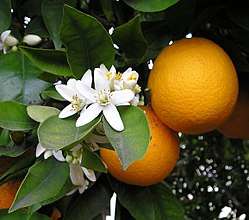 | |
| Sweet orange (Citrus × sinensis cultivar) | |
| Scientific classification | |
| Kingdom: | Plantae |
| Clade: | Angiosperms |
| Clade: | Eudicots |
| Clade: | Rosids |
| Order: | Sapindales |
| Family: | Rutaceae |
| Subfamily: | Aurantioideae |
| Tribe: | Citreae |
| Subtribe: | Citrinae |
| Genus: | Citrus L. |
| Species and hybrids | |
|
Important species: Important hybrids: | |
| Synonyms | |
|
Eremocitrus | |
Citrus is a genus of flowering trees and shrubs in the rue family, Rutaceae. Plants in the genus produce citrus fruits, including important crops like oranges, lemons, grapefruit, pomelo and limes.
The most recent research indicates an origin in the Himalayas.[1] Previous research indicated an origin in the part of Southeast Asia bordered by Northeast India, Burma (Myanmar) and the Yunnan province of China,[2][3][4] and it is in this region that some commercial species such as oranges, mandarins, and lemons originated. Citrus fruit has been cultivated in an ever-widening area since ancient times. It has also been cultivated for the production and consumption of citrus juice.
History
Citrus plants are native to subtropical and tropical regions of Asia and the Malay Archipelago and they were first domesticated in these areas. Some citrus species have been present in the Mediterranean basin for centuries.[5] This group of species has reached great importance in some of the Mediterranean countries and, in the case of orange, mandarin and lemon trees, they found here soil and climatic conditions which allows them to achieve a high level of fruit quality, even better than in the regions where they came from.[5]
The "native" oranges of Florida actually originated with the Spanish Conquistadors.[6][7] The agronomists of classical Rome already made many references to the cultivation of citrus fruits within the limits of their empire.[5] King Louis XIV of France housed citrus in orangeries, to protect the tropical fruit to be grown in the 1600s France.[8]
Name
The generic name originated from Latin, where it referred to either the plant now known as citron (C. medica) or a conifer tree (Thuja). It is somehow related to the ancient Greek word for cedar, κέδρος (kédros). This may be due to perceived similarities in the smell of citrus leaves and fruit with that of cedar.[9] Collectively, Citrus fruits and plants are also known by the Romance loanword agrumes (literally "sour fruits").
Evolution
The large citrus fruit of today evolved originally from small, edible berries over millions of years. Citrus plants diverged from a common ancestor about 15 million years ago, which was about when it diverged from the closely related severinia, for example the Chinese box orange. About 7 million years ago, citrus plants diverged into two groups, the main citrus genus and the ancestors of the Trifoliate orange (poncirus), which is closely enough related that it can still be hybridized with all other citrus. These estimates are made using genetic mapping of plant chloroplasts.[10] A DNA study published in Nature in 2018 concludes that citrus trees originated in the foothills of the Himalayas, in the area of Assam (India), western Yunnan (China), and northern Myanmar.[11]
The three original species in the citrus genus that have been hybridized into most modern commercial citrus fruit are the mandarin orange, pummelo, and citron.[12] Within the last few thousand years, all common citrus fruits (sweet oranges, lemons, grapefruit, limes, and so on) were created by crossing those original species.
Taxonomy


The taxonomy and systematics of the genus are complex and the precise number of natural species is unclear, as many of the named species are hybrids clonally propagated through seeds (by apomixis), and there is genetic evidence that even some wild, true-breeding species are of hybrid origin.
Most cultivated Citrus seem to be natural or artificial hybrids of a small number of core ancestral species[15], including the citron, pummelo, mandarine, and papedas (see image).[16] Natural and cultivated citrus hybrids include commercially important fruit such as oranges, grapefruit, lemons, limes, and some tangerines.
Apart from these core citrus species, there are Australian limes and the recently discovered Mangshanyegan. Kumquats and Clymenia sp. are now generally considered to belong within the citrus genus.[17] Trifoliate orange, which is often used as commercial rootstock, is an outgroup and may or may not be categorized as a citrus.
Phylogenetic analysis suggests the species of Oxanthera from New Caledonia should be transferred to the genus Citrus.[18]
Description
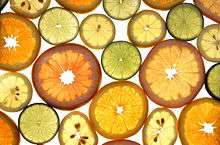
Tree
These plants are large shrubs or small to moderate-sized trees, reaching 5–15 m (16–49 ft) tall, with spiny shoots and alternately arranged evergreen leaves with an entire margin.[19] The flowers are solitary or in small corymbs, each flower 2–4 cm (0.79–1.57 in) diameter, with five (rarely four) white petals and numerous stamens; they are often very strongly scented.
Fruit
The fruit is a hesperidium, a specialised berry, globose to elongated, 4–30 cm (1.6–11.8 in) long and 4–20 cm (1.6–7.9 in) diameter, with a leathery rind or "peel" called a pericarp. The outermost layer of the pericarp is an "exocarp" called the flavedo, commonly referred to as the zest. The middle layer of the pericarp is the mesocarp, which in citrus fruits consists of the white, spongy "albedo", or "pith". The innermost layer of the pericarp is the endocarp. The segments are also called "liths", and the space inside each lith is a locule filled with juice vesicles, or "pulp". From the endocarp, string-like "hairs" extend into the locules, which provide nourishment to the fruit as it develops.[20][21]
Citrus fruits are notable for their fragrance, partly due to flavonoids and limonoids (which in turn are terpenes) contained in the rind, and most are juice-laden. The juice contains a high quantity of citric acid giving them their characteristic sharp flavour. The genus is commercially important as many species are cultivated for their fruit, which is eaten fresh, pressed for juice, or preserved in marmalades and pickles.
They are also good sources of vitamin C and flavonoids. The content of vitamin C in the fruit depends on the species, variety and mode of cultivation. Fruits produced with organic agriculture have been shown to contain more vitamin C than those produced with conventional agriculture in the Algarve, but results depended on the species and cultivar.[22] The flavonoids include various flavanones and flavones.[23]
Cultivation
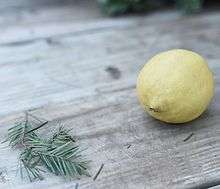

Citrus trees hybridise very readily – depending on the pollen source, plants grown from a Persian lime's seeds can produce fruit similar to grapefruit. Thus all commercial citrus cultivation uses trees produced by grafting the desired fruiting cultivars onto rootstocks selected for disease resistance and hardiness.
The colour of citrus fruits only develops in climates with a (diurnal) cool winter.[24] In tropical regions with no winter at all, citrus fruits remain green until maturity, hence the tropical "green oranges".[25] The Persian lime in particular is extremely sensitive to cool conditions, thus it is not usually exposed to cool enough conditions to develop a mature colour. If they are left in a cool place over winter, the fruits will change colour to yellow.
The terms "ripe" and "mature" are usually used synonymously, but they mean different things. A mature fruit is one that has completed its growth phase. Ripening is the changes that occur within the fruit after it is mature to the beginning of decay. These changes usually involve starches converting to sugars, a decrease in acids and a softening and change in the fruit's colour.[26]
Citrus fruits are non-climacteric and respiration slowly declines and the production and release of ethylene is gradual.[27] The fruits do not go through a ripening process in the sense that they become "tree ripe." Some fruits, for example cherries, physically mature and then continue to ripen on the tree. Other fruits, like pears, are picked when mature but before they ripen, then continue to ripen off the tree. Citrus fruits pass from immaturity to maturity to over-maturity while still on the tree. Once they are separated from the tree, they will not increase in sweetness or continue to ripen. The only way change may happen after being picked is that they will eventually start to decay.
With oranges, colour cannot be used as an indicator of ripeness because sometimes the rinds turn orange long before the oranges are ready to eat. Tasting them is the only way to know whether or not they are ready to eat.
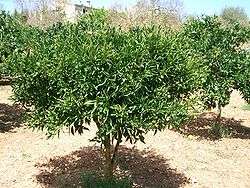
Citrus trees are not generally frost hardy. Mandarin oranges (C. reticulata) tend to be the hardiest of the common Citrus species and can withstand short periods down to as cold as −10 °C (14 °F), but realistically temperatures not falling below −2 °C (28 °F) are required for successful cultivation. Tangerines, tangors and yuzu can be grown outside even in regions with more marked sub-freezing temperatures in winter, although this may affect fruit quality. A few hardy hybrids can withstand temperatures well below freezing, but do not produce quality fruit. Lemons can be commercially grown in cooler-summer/moderate-winter, coastal Southern California, because sweetness is neither attained nor expected in retail lemon fruit. The related trifoliate orange (Citrus trifoliata) can survive below −20 °C (−4 °F); its fruit are astringent and inedible unless cooked but a few better-tasting cultivars and hybrids have been developed (see citranges).
The trees thrive in a consistently sunny, humid environment with fertile soil and adequate rainfall or irrigation. Abandoned trees in valleys may suffer, yet survive, the dry summer of Central California's Inner Coast Ranges. At any age citrus grows well enough with infrequent irrigation in partial shade, but the fruit crop is smaller. Being of tropical and sub-tropical origin, oranges, like all citrus, are broadleaved and evergreen. They do not drop leaves except when stressed. The stems of many varieties have large sharp thorns. The trees flower in the spring, and fruit is set shortly afterward. Fruit begins to ripen in fall or early winter months, depending on cultivar, and develops increasing sweetness afterward. Some cultivars of tangerines ripen by winter. Some, such as the grapefruit, may take up to eighteen months to ripen.
Production

According to UN 2007 data, Brazil, China, the United States, Mexico, India, and Spain are the world's largest citrus-producing countries.
Major commercial citrus growing areas include southern China, the Mediterranean Basin (including southern Spain), South Africa, Australia, the southern United States, Mexico and parts of South America. In the United States, Florida, California, Arizona, and Texas are major producers, while smaller plantings are present in other Sun Belt states and in Hawaii.
As ornamental plants

Citrus trees grown in tubs and wintered under cover were a feature of Renaissance gardens, once glass-making technology enabled sufficient expanses of clear glass to be produced. An orangery was a feature of royal and aristocratic residences through the 17th and 18th centuries. The Orangerie at the Palace of the Louvre, 1617, inspired imitations that were not eclipsed until the development of the modern greenhouse in the 1840s. In the United States the earliest surviving orangery is at the Tayloe House, Mount Airy, Virginia. George Washington had an orangery at Mount Vernon.
Some modern hobbyists still grow dwarf citrus in containers or greenhouses in areas where it is too cold to grow it outdoors. Consistent climate, sufficient sunlight, and proper watering are crucial if the trees are to thrive and produce fruit. Compared to many of the usual "green shrubs", citrus trees better tolerate poor container care. For cooler winter areas, limes and lemons should not be grown, since they are more sensitive to winter cold than other citrus fruits. Hybrids with kumquats (× Citrofortunella) have good cold resistance. A citrus tree in a container may have to be re-potted every 5 years or so since the roots may form a thick "root-ball" on the bottom of the pot.[8]
Pests and diseases

Citrus plants are very liable to infestation by aphids, whitefly and scale insects (e.g. California red scale). Also rather important are the viral infections to which some of these ectoparasites serve as vectors such as the aphid-transmitted Citrus tristeza virus which when unchecked by proper methods of control is devastating to citrine plantations. The newest threat to citrus groves in the United States is the Asian citrus psyllid.
The Asian citrus psyllid is an aphid-like insect that feeds on the leaves and stems of citrus trees and other citrus-like plants. The real danger lies that the psyllid can carry a deadly, bacterial tree disease called Huanglongbing (HLB), also known as citrus greening disease.[28]
In August 2005 citrus greening disease was discovered in the south Florida region around Homestead and Florida City. The disease has since spread to every commercial citrus grove in Florida. In 2004–2005 USDA Ag statistics reported the total Florida citrus production to be 169.1 million boxes of fruit. The estimate for all Florida citrus production in the 2015–2016 season is 94.2 million boxes—a 44.3% drop.[29]
In June 2008, the psyllid was spotted dangerously close to California – right across the international border in Tijuana, Mexico. Only a few months later, it was detected in San Diego and Imperial counties, and has since spread to Riverside, San Bernardino, Orange, Los Angeles and Ventura counties sparking quarantines in those areas. The Asian citrus psyllid has also been intercepted coming into California in packages of fruit and plants, including citrus, ornamentals, herbs and bouquets of cut flowers, shipped from other states and countries.[28]
The foliage is also used as a food plant by the larvae of Lepidoptera (butterfly and moth) species such as the Geometridae common emerald (Hemithea aestivaria) and double-striped pug (Gymnoscelis rufifasciata), the Arctiidae giant leopard moth (Hypercompe scribonia), H. eridanus, H. icasia and H. indecisa, many species in the family Papilionidae (swallowtail butterflies), and the black-lyre leafroller moth ("Cnephasia" jactatana), a tortrix moth.
Since 2000, the citrus leafminer (Phyllocnistis citrella) has been a pest in California,[30] boring meandering patterns through leaves.
In eastern Australia, the bronze-orange bug (Musgraveia sulciventris) can be a major pest of citrus trees, particularly grapefruit. In heavy infestations it can cause flower and fruit drop and general tree stress.
European brown snails (Cornu aspersum) can be a problem in California, though laying female Khaki Campbell and other mallard-related ducks can be used for control.
Deficiency diseases
Citrus plants can also develop a deficiency condition called chlorosis, characterized by yellowing leaves[31] highlighted by contrasting leaf veins. The shriveling leaves eventually fall, and if the plant loses too many, it will slowly die. This condition is often caused by an excessively high pH (alkaline soil), which prevents the plant from absorbing iron, magnesium, zinc, or other nutrients it needs to produce chlorophyll. This condition can be cured by adding an appropriate acidic fertilizer formulated for citrus, which can sometimes revive a plant to produce new leaves and even flower buds within a few weeks under optimum conditions. A soil which is too acidic can also cause problems; citrus prefers neutral soil (pH between 6 and 8). Citrus plants are also sensitive to excessive salt in the soil. Soil testing may be necessary to properly diagnose nutrient deficiency diseases.[32]
Uses
Culinary


Many citrus fruits, such as oranges, tangerines, grapefruits, and clementines, are generally eaten fresh. They are typically peeled and can be easily split into segments. Grapefruit is more commonly halved and eaten out of the skin with a spoon.[33] There are special spoons (grapefruit spoons) with serrated tips designed for this purpose. Orange and grapefruit juices are also very popular breakfast beverages. More acidic citrus, such as lemons and limes, are generally not eaten on their own. Meyer lemons can be eaten out of hand with the fragrant skin; they are both sweet and sour. Lemonade or limeade are popular beverages prepared by diluting the juices of these fruits and adding sugar. Lemons and limes are also used as garnishes or in cooked dishes. Their juice is used as an ingredient in a variety of dishes; it can commonly be found in salad dressings and squeezed over cooked meat or vegetables.
A variety of flavours can be derived from different parts and treatments of citrus fruits. The rind and oil of the fruit is generally very bitter, especially when cooked, and so is often combined with sugar. The fruit pulp can vary from sweet to extremely sour. Marmalade, a condiment derived from cooked orange and lemon, can be especially bitter, but is usually sweetened to cut the bitterness and produce a jam-like result. Lemon or lime is commonly used as a garnish for water, soft drinks, or cocktails. Citrus juices, rinds, or slices are used in a variety of mixed drinks. The colourful outer skin of some citrus fruits, known as zest, is used as a flavouring in cooking; the white inner portion of the peel, the pith, is usually avoided due to its bitterness. The zest of a citrus fruit, typically lemon or an orange, can also be soaked in water in a coffee filter, and drunk.
Medical
Citrus fruits have well-documented nutritional and health benefits.[5] They can actually help prevent and cure some diseases.[5]
Citrus fruit intake has been associated with a 10% reduction in odds of developing breast cancer.[34]
Oranges were historically used for their high content of vitamin C,[22] which prevents scurvy. Scurvy is caused by vitamin C deficiency, and can be prevented by having 10 milligrams of vitamin C a day. An early sign of scurvy is fatigue. If ignored, later symptoms are bleeding and bruising easily. British sailors were given a ration of citrus fruits on long voyages to prevent the onset of scurvy, hence the British nickname of Limey.
Pectin is a structural heteropolysaccharide contained in the primary cell walls of plants. Limes and lemons as well as oranges and grapefruits are among the highest in this level.[35]
After consumption, the peel is sometimes used as a facial cleanser.
Before the development of fermentation-based processes, lemons were the primary commercial source of citric acid.
Citrus fruit intake is associated with a reduced risk of stomach cancer.[36] Also, citrus fruit juices, such as orange, lime and lemon, may be useful for lowering the risk of specific types of kidney stones. Grapefruit is another fruit juice that can be used to lower blood pressure because it interferes with the metabolism of calcium channel blockers.[37] Lemons have the highest concentration of citrate of any citrus fruit, and daily consumption of lemonade has been shown to decrease the rate of kidney stone formation.[38]
Sweet and sour
The Moroccan professor Henri Chapot discovered that the acidity in the more common citrons or lemons is represented by red on the inner coat of seeds specifically on the chalazal spot, violet pigmentation on the outer side of the flower blossom, and also by the new buds that are reddish-purplish. The acidless varieties of citrus are completely lacking the red color in all the mentioned spots.[39] This designation was cited by Herbert John Webber and Leon Dexter Batchelor, the editors of the fundamental treatise on citrus, namely The Citrus Industry, which was published by the University of California, Riverside in 1967.
Fossil record
A fossil leaf from the Pliocene of Valdarno (Italy) is described as †Citrus meletensis.[40] In China fossil leaf specimens of †Citrus linczangensis have been collected from coal-bearing strata of the Bangmai Formation in the Bangmai village, about 10 km northwest of Lincang City, Yunnan. The Bangmai Formation contains abundant fossil plants and is considered to be of late Miocene age, Citrus linczangensis and C. meletensis share some important characters, such as an intramarginal vein, an entire margin, and an articulated and distinctly winged petiole.[41]
List of citrus fruits
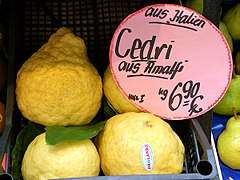
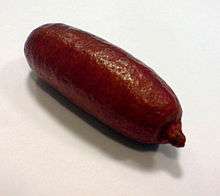
The genus Citrus has been suggested to originate in the eastern Himalayan foothills. Prior to human cultivation, it consisted of just a few species, though the status of some as distinct species has yet to be confirmed:
- Citrus crenatifolia – species name is unresolved, from Sri Lanka
- Citrus japonica – Kumquats, from East Asia ranging into Southeast Asia (sometimes separated in 4–5 Fortunella species)
- Citrus mangshanensis – species name is unresolved, from Hunan Province, China.
- Citrus maxima – Pomelo (pummelo, shaddock), from the Malay Archipelago
- Citrus medica – Citron, from India
- Citrus platymamma – Byeonggyul, from Jeju Island, Korea
- Citrus reticulata – Mandarin orange, from China
- Citrus trifoliata – Trifoliate orange, from Korea and adjacent China (often separated as Poncirus)
- Australian limes
- Citrus australasica – Australian Finger Lime
- Citrus australis – Australian Round lime
- Citrus glauca – Australian Desert Lime
- Citrus garrawayae – Mount White Lime
- Citrus gracilis – Kakadu Lime or Humpty Doo Lime
- Citrus inodora – Russel River Lime
- Citrus warburgiana – New Guinea Wild Lime
- Citrus wintersii – Brown River Finger Lime
- Papedas, including
- Citrus halimii – limau kadangsa, limau kedut kera, from Thailand and Malaya
- Citrus hystrix – Kaffir lime, makrut
- Citrus ichangensis – Ichang Papeda
- Citrus indica – Indian wild orange, from the Indian subcontinent[42]
- Citrus latipes – Khasi Papeda, from Assam, Meghalaya, Burma[42]
- Citrus macroptera from Indochina and Melanesia[42]
- Citrus micrantha from the southern Philippines[43]
Hybrids and cultivars
.jpg)
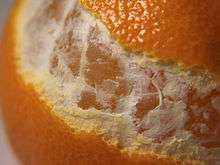


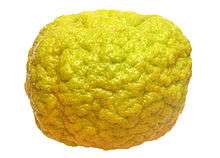
Sorted by parentage. As each hybrid is the product of (at least) two parent species, they are listed multiple times.
Citrus maxima-based
- Amanatsu, natsumikan – Citrus ×natsudaidai (C. maxima × unknown)
- Cam sành – (C. reticulata × C. ×sinensis)
- Dangyuja – (Citrus grandis Osbeck)
- Grapefruit – Citrus ×paradisi (C. maxima × C. ×sinensis)
- Imperial lemon – (C. ×limon × C. ×paradisi)
- Kinnow – (C. ×nobilis × C. ×deliciosa)
- Kiyomi – (C. ×sinensis × C. ×unshiu)
- Minneola tangelo – (C. reticulata × C. ×paradisi)
- Orangelo, Chironja – (C. ×paradisi × C. ×sinensis)
- Oroblanco, Sweetie – (C. maxima × C. ×paradisi)
- Sweet orange – Citrus ×sinensis (probably C. maxima × C. reticulata)
- Tangelo – Citrus ×tangelo (C. reticulata × C. maxima or C. ×paradisi)
- Tangor – Citrus ×nobilis (C. reticulata × C. ×sinensis)
- Ugli – (C. reticulata × C. maxima or C. ×paradisi)
Citrus medica-based
- Alemow, Colo – Citrus ×macrophylla (C. medica × C. micrantha)
- Buddha's hand – Citrus medica var. sarcodactylus, a fingered citron.
- Citron varieties with sour pulp – Diamante citron, Florentine citron, Greek citron and Balady citron
- Citron varieties with sweet pulp – Corsican citron and Moroccan citron.
- Etrog, a group of citron cultivars that are traditionally used for a Jewish ritual. Etrog is Hebrew for citron in general.
- Fernandina – Citrus ×limonimedica (probably (C. medica × C. maxima) × C. medica)
- Ponderosa lemon – (probably (C. medica × C. maxima) × C. medica)
- Lemon – Citrus ×limon (C. medica × C. ×aurantium)
- Key lime, Mexican lime, Omani lime – Citrus ×aurantiifolia (C. medica × C. micrantha)
- Limetta, Sweet Lemon, Sweet Lime, mosambi – Citrus ×limetta (C. medica × C. ×aurantium)
- Lumia – a pear shaped lemon hybrid, (several distinct hybrids)
- Persian lime, Tahiti lime – C. xlatifolia (C. xaurantiifolia x C. xlimon)
- Rhobs el Arsa – bread of the garden, a Moroccan citron x lemon hybrid.
- Yemenite citron – a pulpless true citron.
Citrus reticulata–based
- Bergamot orange – Citrus ×bergamia (C. ×limon × C. ×aurantium)
- Bitter orange, Seville Orange – Citrus ×aurantium (C. maxima × C. reticulata)
- Blood orange – Citrus ×sinensis cultivars
- Calamondin, Calamansi – (Citrus reticulata × Citrus japonica)
- Cam sành – (C. reticulata × C. ×sinensis)
- Chinotto – Citrus ×aurantium var. myrtifolia or Citrus ×myrtifolia
- ChungGyun – Citrus reticulata cultivar
- Clementine – Citrus ×clementina
- Cleopatra Mandarin – Citrus ×reshni
- Siranui – Citrus reticulata cv. 'Dekopon' (ChungGyun × Ponkan)
- Daidai – Citrus ×aurantium var. daidai or Citrus ×daidai
- Grapefruit – Citrus ×paradisi (C. maxima × C. ×sinensis)
- Hermandina – Citrus reticulata cv. 'Hermandina'
- Imperial lemon – ((C. maxima × C. medica) × C. ×paradisi)
- Kinnow, Wilking – (C. ×nobilis × C. ×deliciosa)
- Kiyomi – (C. sinensis × C. ×unshiu)
- Laraha – ''C. ×aurantium ssp. currassuviencis
- Mediterranean mandarin, Willow Leaf – Citrus ×deliciosa
- Meyer lemon, Valley Lemon – Citrus ×meyeri (C. medica × C. ×sinensis)
- Michal mandarin – Citrus reticulata cv. 'Michal'
- Mikan, Satsuma – Citrus ×unshiu
- Naartjie – (C. reticulata × C. nobilis)
- Nova mandarin, Clemenvilla
- Orangelo, Chironja – (C. ×paradisi × C. ×sinensis)
- Oroblanco, Sweetie – (C. maxima × C. ×paradisi)
- Palestine sweet lime – Citrus ×limettioides Tanaka (C. medica × C. ×sinensis)
- Ponkan – Citrus reticulata cv. 'Ponkan'
- Rangpur, Lemanderin, Mandarin Lime – Citrus ×limonia (C. reticulata × C. medica)
- Rough lemon – Citrus ×jambhiri Lush. (C. reticulata × C. medica)
- Shekwasha, Hirami Lemon, Taiwan Tangerine – Citrus ×depressa
- Sunki, Suenkat – Citrus sunki or C. reticulata var. sunki
- Sweet orange – Citrus ×sinensis (C. maxima × C. reticulata)
- Tachibana orange – Citrus tachibana (Mak.) Tanaka or C. reticulata var. tachibana
- Tangelo – Citrus ×tangelo (C. reticulata × C. maxima or C. ×paradisi)
- Tangerine – Citrus ×tangerina
- Tangor – Citrus ×nobilis (C. reticulata × C. ×sinensis)
- Ugli – (C. reticulata × C. maxima or C. ×paradisi)
- Volkamer lemon – Citrus ×volkameriana (C. reticulata × C. medica)
- Yuzu – Citrus ×junos (C. reticulata × C. ×ichangensis)
Other/Unresolved
- Djeruk limau – Citrus ×amblycarpa
- Gajanimma, Carabao Lime – Citrus ×pennivesiculata
- Hyuganatsu, Hyuganatsu pumelo – Citrus tamurana
- Ichang lemon – (C. ichangensis × C. maxima)
- Imperial lemon, Shangjuan – (C. ×limon × C. ×paradisi)
- Iyokan, anadomikan – Citrus ×iyo
- Kabosu – Citrus ×sphaerocarpa
- Odichukuthi – Citrus Odichukuthi from Malayalam
- Ougonkan – Citrus flaviculpus hort ex.Tanaka
- Pompia – Citrus limon var. pompia Camarda, 2015, formerly Citrus monstruosa, a nomen nudum[44]
- Sakurajima komikan orange
- Shonan gold – (Ougonkan) Citrus flaviculpus hort ex. Tanaka × (Imamura unshiu), Citrus unshiu Marc
- Sudachi – Citrus ×sudachi
For hybrids with kumquats, see citrofortunella. For hybrids with the Trifoliate Orange, see citrange.
See also
Footnotes
- ↑ Wu GA, Terol J, Ibanez V, López-García A, Pérez-Román E, Borredá C, Domingo C, Tadeo FR, Carbonell-Caballero J, Alonso R, Curk F, Du D, Ollitrault P, Roose ML, Dopazo J, Gmitter FG, Rokhsar DS, Talon M (February 2018). "Genomics of the origin and evolution of Citrus". Nature. 554 (7692): 311–316. doi:10.1038/nature25447. PMID 29414943.
- ↑ Gmitter, Frederick; Hu, Xulan (1990). "The possible role of Yunnan, China, in the origin of contemporary Citrus species (Rutaceae)". Economic Botany. 44 (2): 267–277. doi:10.1007/bf02860491.
- ↑ United Nations Conference on Trade and Development. Market Information in the Commodities Area: Citrus fruits "CHARACTERISTICS". Archived from the original on 2010-10-05. Retrieved 2010-09-24.
- ↑ Scora, Rainer W. (1975). "On the history and origin of citrus". Bulletin of the Torrey Botanical Club. 102 (6): 369–375. doi:10.2307/2484763. JSTOR 2484763.
- 1 2 3 4 5 Duarte,, A.; Fernandes,, J.; Bernardes,, J.; Miguel, G. (2016). "Citrus as a Component of the Mediterranean Diet". Journal of Spatial and Organizational Dynamics. 4: 289–304.
- ↑ University of South Florida: Fruit
Contrary to general belief, the orange tree is not indigenous to Florida but was introduced into the state from Valencia by the Spanish colonists. - ↑ History of the Citrus and Citrus Tree Growing in America
Many of these wild orange groves were seen by the early American explorer, William Bartram, according to his book, Travels, in 1773, while traveling down the Saint John’s River in Florida. Bartram mistakenly thought these orange trees were native to Florida; however, they were established centuries earlier by the Spanish explorers. - 1 2 Lance., Walheim, (1996). Citrus : complete guide to selecting & growing more than 100 varieties for California, Arizona, Texas, the Gulf Coast and Florida. Tucson, Ariz.: Ironwood Press. ISBN 978-0-9628236-4-0. OCLC 34116821.
- ↑ Spiegel-Roy, Pinchas; Eliezer E. Goldschmidt (1996). Biology of Citrus. Cambridge University Press. p. 4. ISBN 978-0-521-33321-4.
- ↑ A phylogenetic analysis of 34 chloroplast genomes elucidates the relationships between wild and domestic species within the genus Citrus
- ↑ Briggs, Helen (8 Feb 2018), "DNA Story of when life first gave us lemons," BBC, https://www.bbc.com/news/science-environment-42960445, accessed 12 Feb 2018
- ↑ Velasco, Riccardo; Licciardello, Concetta (2014). "A genealogy of the citrus family". Nature Biotechnology. 32 (7): 640–642. doi:10.1038/nbt.2954. PMID 25004231 – via www.nature.com.
- ↑ Curk, Franck; Ollitrault, Frédérique; Garcia-Lor, Andres; Luro, François; Navarro, Luis; Ollitrault, Patrick (2016). "Phylogenetic origin of limes and lemons revealed by cytoplasmic and nuclear markers". Annals of Botany. 11 (4): 565–583. doi:10.1093/aob/mcw005. PMC 4817432. PMID 26944784.
- ↑ Curk, Franck; Ancillo, Gema; Garcia-Lor, Andres; Luro, François; Perrier, Xavier; Jacquemoud-Collet, Jean-Pierre; Navarro, Luis; Ollitrault, Patrick (December 2014). "Next generation haplotyping to decipher nuclear genomic interspecific admixture in Citrusspecies: analysis of chromosome 2". BMC Genetics. 15 (1): 152. doi:10.1186/s12863-014-0152-1. ISSN 1471-2156. PMC 4302129. PMID 25544367.
- ↑ "International Citrus Genomics Consortium". ucr.edu.
- ↑ Klein, Joshua D. (2014). Citron Cultivation, Production and Uses in the Mediterranean Region. Springer.com. Medicinal and Aromatic Plants of the World. 2. pp. 199–214. doi:10.1007/978-94-017-9276-9_10. ISBN 978-94-017-9275-2.
- ↑ Andrés García Lor (2013). Organización de la diversidad genética de los cítricos (PDF) (Thesis). p. 79.
- ↑ Bayer, R. J., et al. (2009). A molecular phylogeny of the orange subfamily (Rutaceae: Aurantioideae) using nine cpDNA sequences. American Journal of Botany 96(3), 668–85.
- ↑ Del Hotal, Tom. "CITRUS PRUNING" (PDF). California Rare Fruit Growers.
- ↑ "Citrus fruit diagram". ucla.edu. Archived from the original on 2012-10-03.
- ↑ "Lith". TheFreeDictionary.com.
- 1 2 Duarte, A; Caixeirinho, D; Miguel, G; Nunes, C; Mendes, M; Marreiros, A (2010). "Vitamin C Content of Citrus from Conventional versus Organic Farming Systems". Acta Horticulturae. 868 (868): 389–394. doi:10.17660/ActaHortic.2010.868.52.
- ↑ "Flavonoid Composition of Fruit Tissues of Citrus Species". Archived from the original on 2007-05-28. Retrieved 2011-07-05.
- ↑ "Citrus". Retrieved 2015-04-13.
- ↑ SHAILES, SARAH (December 2014). "Why is my orange green?". Plant Scientist.
- ↑ Helgi Öpik; Stephen A. Rolfe; Arthur John Willis; Herbert Edward Street (2005). The physiology of flowering plants. Cambridge University Press. pp. 309–. ISBN 978-0-521-66251-2. Retrieved 31 July 2010.
- ↑ Pinchas Spiegel-Roy; Eliezer E. Goldschmidt (1996). Biology of citrus. Cambridge University Press. pp. 101–. ISBN 978-0-521-33321-4. Retrieved 31 July 2010.
- 1 2 "About the Asian Citrus Psyllid and Huanglongbing". californiacitrusthreat.org.
- ↑ "Florida Citrus Statistics 2015–2016" (PDF). United States Department of Agriculture – National Agricultural Statistics Service. 3 October 2017. Retrieved 3 October 2017.
- ↑ "Citrus Leafminer – UC Pest Management".
- ↑ Online at SumoGardener "How to Avoid Yellow Leaves on Citrus Trees". 2016-07-09.
- ↑ Mauk, Peggy A.; Tom Shea. "Questions and Answers to Citrus Management (3rd ed.)" (PDF). University of California Cooperative Extension. Retrieved 2014-05-24.
- ↑ "American Indian Health – Health". Aihd.ku.edu. Retrieved 2011-12-17.
- ↑ Song, Jung-Kook; Bae, Jong-Myon (2013-03-01). "Citrus fruit intake and breast cancer risk: a quantitative systematic review". Journal of Breast Cancer. 16 (1): 72–76. doi:10.4048/jbc.2013.16.1.72. ISSN 1738-6756. PMC 3625773. PMID 23593085.
- ↑ Morgan, Laura (15 March 2011). "What Fruits & Vegetables Contain Pectin?". Demand Media. Retrieved 2011-07-22.
- ↑ González CA, Sala N, Rokkas T (2013). "Gastric cancer: epidemiologic aspects". Helicobacter. 18 (Supplement 1): 34–38. doi:10.1111/hel.12082. PMID 24011243.
- ↑ "Grapefruit and Medication". Total Health. 27 (2): 39. 2005.
- ↑ Carr, Jackie (22 April 2010). "Five Ways to Prevent Kidney Stones". UC San Diego. Archived from the original on 20 November 2010. Retrieved 2010-12-03.
- ↑ Un curieux cedrat Marocain (1950) Rev. Intl. Bot. Appl. Agr. Trop. 30:506–514.
- ↑ Citrus meletensis (Rutaceae), a new species from the Pliocene of Valdarno (Italy) Fischer, T.C. & Butzmann, Plant Systematics and Evolution – March 1998, Volume 210, Issue 1, pp 51–55. doi:10.1007/BF00984727
- ↑ Citrus linczangensis sp. n., a Leaf Fossil of Rutaceae from the Late Miocene of Yunnan, China by Sanping Xie, Steven R Manchester, Kenan Liu and Bainian Sun – International Journal of Plant Sciences 174(8):1201–1207 October 2013.
- 1 2 3 GRIN. "Species list in GRIN for genus Citrus". Taxonomy for Plants. National Germplasm Resources Laboratory, Beltsville, Maryland: USDA, ARS, National Genetic Resources Program. Archived from the original on 20 January 2009. Retrieved 6 January 2011.
- ↑ P. J. Wester (1915), "Citrus Fruits In The Philippines", Philippine Agricultural Review, 8
- ↑ Pompia Citron oscartintori.it, accessed 2 October 2018
References
- Andrews, A.C. (1961). "Acclimatization of citrus fruits in the Mediterranean region". Agricultural History. 35 (1): 35–46.
- Araújo, De; Freitas, E.; de Queiroz, L. Paganucci; Machado, M.A. (2003). "What is Citrus? Taxonomic implications from a study of cp-DNA evolution in the tribe Citreae (Rutaceae subfamily Aurantioideae)". Organisms Diversity & Evolution. 3 (1): 55–62. doi:10.1078/1439-6092-00058.
- Duarte, A.; Fernandes, J.; Bernardes, J.; Miguel, G. 2016. Citrus as a Component of the Mediterranean Diet. Journal of Spatial and Organizational Dynamics – JSOD, IV(4): 289–304.
- Nicolosi, E.; Deng, Z.N.; Gentile, A.; La Malfa, S.; Continella, G.; Tribulato, E. (2000). "Citrus phylogeny and genetic origin of important species as investigated by molecular markers". Theoretical and Applied Genetics. 100 (8): 1155–1166. doi:10.1007/s001220051419.
Further reading
- Calabrese, Francesco (2002): Origin and history. In: Dugo, Giovanni & Di Giacomo, Angelo (eds.) (2002): Citrus. Taylor & Francis. ISBN 0-415-28491-0
- Ellis, R.H.; Hong, T.D. & Roberts, E.H. (1985): Chapter 64. Rutaceae. In: Handbook of Seed Technology for Genebanks (Volume II: Compendium of Specific Germination Information and Test Recommendations). International Board for Plant Genetic Resources, Rome, Italy. HTML fulltext
- Frison, E.A. & Taher, M.M. (eds.) (1991): FAO/IBPGR Technical Guidelines for the Safe Movement of Citrus Germplasm. FAO, IOCV, IPGRI. PDF fulltext
- International Plant Genetic Resources Institute (IPGRI) (1999): Descriptors for Citrus (Citrus spp.). PDF fulltext
- Janick, Jules (2005): Purdue University Tropical Horticulture Lecture 32: Citrus
- Luro, F.; Laigret, F.; Bové, J.M. & Ollitrault, P. (1995): RFLP analysis of cytoplasmic and nuclear genomes used for citrus taxonomy. In: Mandarines – développements scientifiques récents, résumés oraux et posters: 12–13. CIRAD-FLHOR, San Nicolao, France. HTML abstract
- Molina, A.B.; Roa, V.N.; Bay-Petersen, J.; Carpio, A.T. & Joven, J.E.A. (eds.) (2000): Citrus, Proceedings of a regional workshop on disease management of banana and citrus through the use of disease-free planting materials held in Davao City, Philippines, 14–16 October 1998. INIBAP. PDF fulltext
- Sackman. Douglas Cazaux (2005): Orange Empire: California and the Fruits of Eden.
- University of California Division of Agricultural Sciences (UC-DAS) (1967–1989): The Citrus Industry. HTML fulltext of Vol. 1, 2, & Vol. 5, Chapter 5
External links
- Effects of pollination on Citrus plants Pollination of Citrus by Honey Bees
- Citrus Research and Education Center of IFAS (largest citrus research center in world)
- Citrus Variety Collection by the University of California
- Citrus (Mark Rieger, Professor of Horticulture, University of Georgia)
- Fundecitrus – Fund for Citrus Plant Protection is an organization of citrus Brazilian producers and processors.
- Citrus – taxonomy fruit anatomy at GeoChemBio
- Porcher Michel H.; et al. (1995). "Multilingual Multiscript Plant Name Database (M.M.P.N.D) – A Work in Progress". School of Agriculture and Food Systems, Faculty of Land & Food Resources, The University of Melbourne. Australia.

